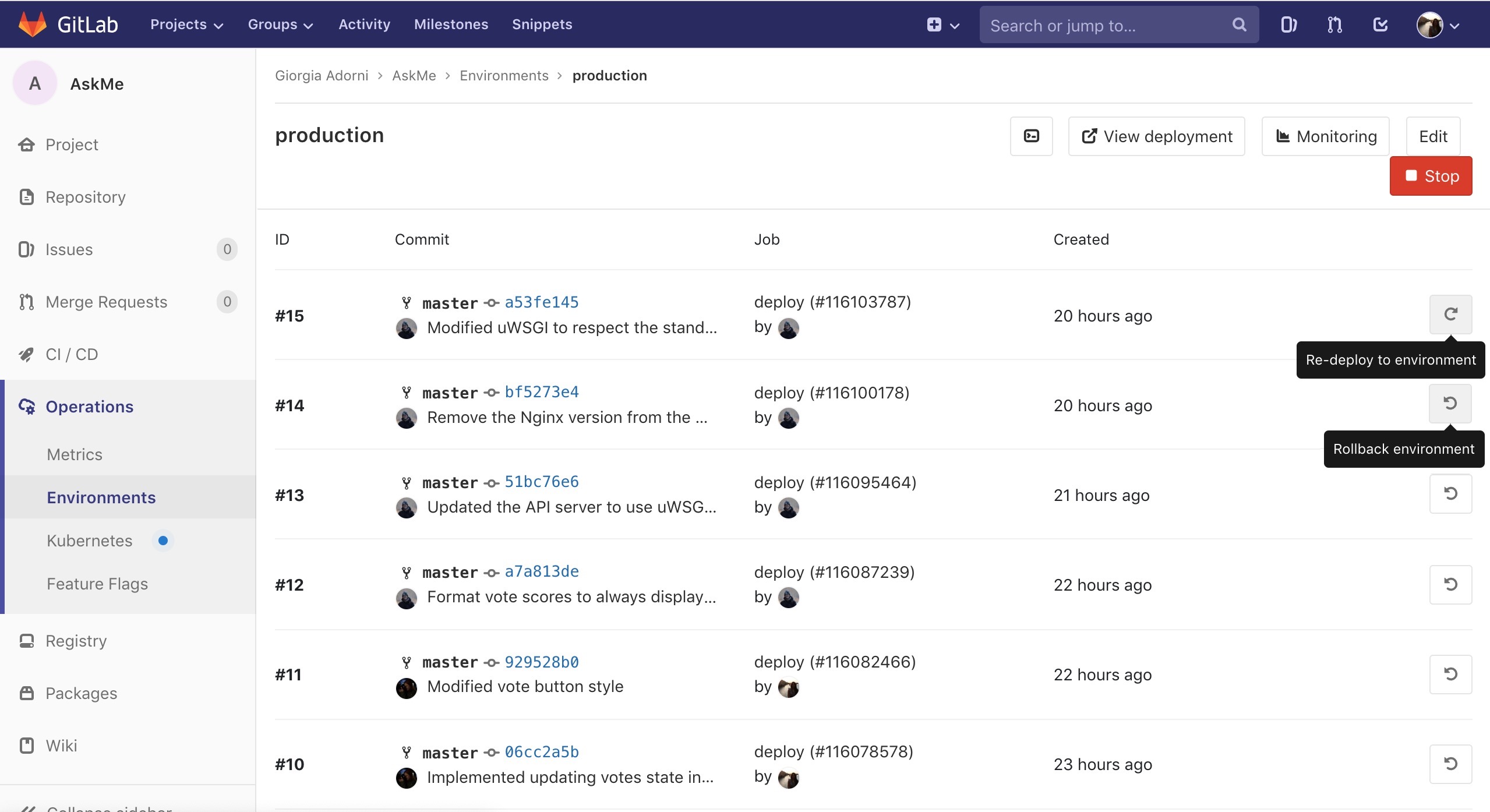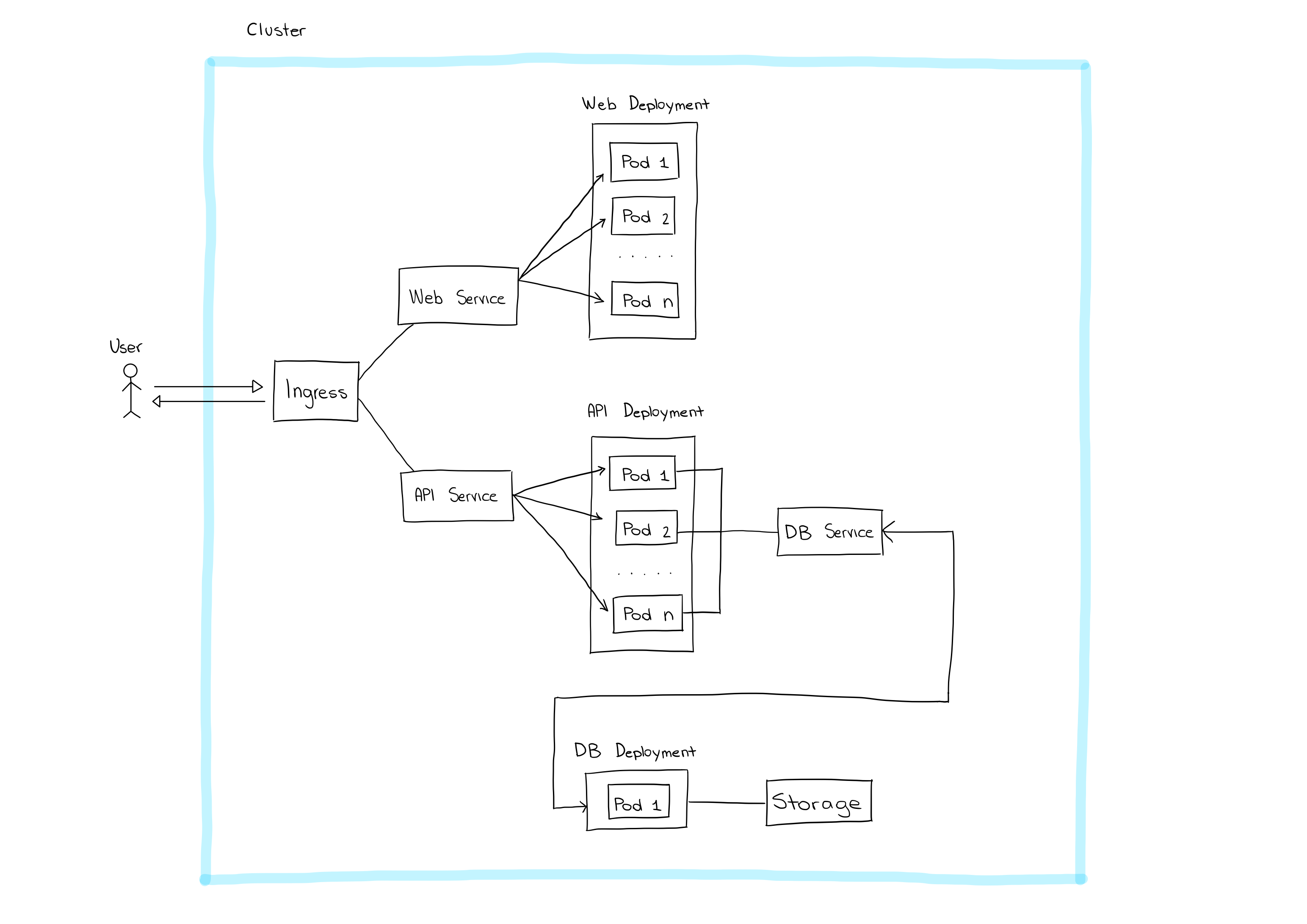AskMe is a simple Q&A application built on the model of StackOverflow. It supports asking questions, posting answers and up- or down-voting existing answers.
The production web application is available at https://askme.cereda.me/.
NOTE: since the application is deployed on Google Cloud, which is a paid service, we're not leaving it online at all times. We plan to show it in action at the project demo, but if you would like to access it beforehand, please contact us and we will gladly start the server.
The source code is available on GitLab at https://gitlab.com/GiorgiaAuroraAdorni/askme/.
This project has been developed by Giorgia Adorni (806787) and Elia Cereda (807539).
We decided to address three aspects of the DevOps process:
- Containerization
- Continuous Integration / Continuous Deployment
- Provisioning
The application has a distributed architecture composed of three main components:
- web interface: a client-side web application built with React, through which the users interact with the platform.
- API server: a web service built using Python and the Flask microframework that exposes the REST API used by the frontend.
- database: a PostgreSQL instance responsible for persistently storing the users' data.
Thanks to Docker Compose, the process of setting up a local development environment is extremely streamlined. These three commands are all that it's needed to spin up and debug the application:
$ git clone https://gitlab.com/GiorgiaAuroraAdorni/askme.git
$ cd askme
$ docker-compose up
The web interface will be available at http://localhost:3000/
and the API server will be available at http://localhost:5000/api/.
In addition, our docker-compose.yml file also starts an instance of pgAdmin to
access the database directly: you can reach it at http://localhost:5005/.
Docker Compose also allows to locally run the unit tests for both the web interface and API server:
$ docker-compose run api python -m pytest
$ docker-compose run web npm test
We use Docker to containerize each of the three components. This allows us to simplify the setup process of the development environment and to create deployable images that contain all dependencies needed by a component.
We wrote the Dockerfiles to take advantage of
multi-stage builds
and build arguments to be able to produce two types of images from a single
configuration: full-featured development images with compilers, debugger support
and live code reloading and slimmed down production images that include just
the bare minimum required to execute the application.
For example, the web interface requires Node.js and a large number of other dependencies during development and compilation, while only requiring a static web server (such as Nginx) in production. Copying only the compiled files to production allowed us to create extremely small and efficient images.
We wrote tests for the API server with pytest and for the web interface with the tools provided by React.
Using GitLab CI, we have set up a pipeline of Continuous Integration that runs after every commit:
- building Docker images
- running unit tests
- publishing images to GitLab Container Registry
With Continuous Deployment, commits that successfully pass all stages of the CI pipeline are published to the production environment automatically. This ensures that only functioning builds are released to the customers.
In .gitlab-ci.yml file we configure the three stages of our pipeline: build, test, and deploy.
On any push GitLab will look for the .gitlab-ci.yml file and start jobs on Runners
according to the contents of the file, for that commit.
GitLab interface provides a visualization of the pipeline status.
This screen displays the deployment history, and allows re-deployment and rollback.

We originally planned to deploy our application to a shared Kubernetes cluster offered by GARR Cloud. Unfortunately, due to the multi-tenant nature of the cluster, we didn't have the authorizations to perform some actions and we needed assistance from GARR. The most significant problem we encountered was provisioning persistent storage for our database in Kubernetes.
Since the deadline for this assignment coincided with the week of November 1st, we couldn't get an answer in time from GARR and we decided to use another service to deploy our application.
We choose to use Google Cloud for two main reasons:
- They offer a very strong managed service, called Google Kubernetes Engine, that allows to run containerized applications without having to manually install a Kubernetes cluster. It natively supports auto-scaling for both Pods and Nodes, even across multiple zones in a Google Cloud region for fault tolerance and high availability.
- They use an attractive pricing scheme that includes 300$ of credit for new users and no charge for using GKE beyond the cost of the virtual machines used as Kubernetes Nodes.
The k8s/ folder in the repository contains the Kubernetes manifests we used to
set up our cluster and some shell scripts we wrote to manage it:
gke-cluster-create.shcreates a Kubernetes cluster with a single node on GKEgke-cluster-pause.shpauses an existing cluster to avoid being charged when not neededgke-cluster-resume.shresumes the cluster by recreating the resources that were deleteddeploy.shis used by our CI/CD pipeline to update the images used by an existing deployment
This diagram describes the architecture of our production environment:

Pods are the smallest deployable object represented by Kubernetes: they represent a number of containers that are guaranteed to be scheduled on the same Node. Attached to a Pod are also the resources needed by its containers, such as storage volumes and IP addresses. In our case, each Pod runs a single container.
Deployments describe the desired state of a group of Pods. In particular they specify what Docker image should be used and how many replicas of a Pod should be scheduled. A Deployment monitors its Pods and acts to maintain the desired state: it's able to restart crashed Pods and to perform rolling updates of its Pods.
For the web and API Deployments this means being able to schedule whatever number of Pods is required and seamlessly update the images with zero downtime for users. If we enabled auto-scaling, it would also be possible to dynamically spin up and shutdown Pods based on the real-time load.
Since the database is a stateful application, achieving scalability is harder than with the other components and it would require cooperation from the DBMS. At the moment our Deployment can only schedule a single database instance.
Services provide an abstraction over a set of Pods that expose a certain functionality. It allows clients to use a single endpoint, a combination of a virtual IP address and a port, to access the service while Kubernetes distributes requests among the specific Pods providing it.
Inside the cluster, Kubernetes also provides a dynamic DNS record for each
Service that can be used to access it: db-service, api-service, web-service.
The Ingress provides a single access point for users to connect to the cluster. In the Google Cloud implementation, this is an extremely powerful component and it's almost overkill for our purposes. Its features include:
- Global load balancing that receives traffic on a single anycast IP address and distributes it to the Google Cloud region closest to the user, with automatic fail-over should a region become unavailable. Given that we only run our cluster in a single region we're not able to take advantage of this.
- HTTPS termination with automatic certificate provisioning from Let's Encrypt, which allowed us to secure our application with HTTPS at no extra cost and with no changes to our application code.
- URL-based mapping that allows to map requests to the corresponding service
based on its URL. We forward requests that begin with
askme.cereda.me/api/to our API server and all other requests to our web server.
At present, no monitoring activity is carried out, even if, using some tools integrated with Google Cloud, it's possible to conduct analysis and management of containerized applications.
-
Uptime monitoring: Stackdriver Monitoring allows to visualize significant information, automatically collected, such as performance, activity time and overall status of applications running in the cloud environment, in the form of dashboards, graphs and alerts.
-
Logging: Stackdriver Logging allows to store, search, analyze the real time and create alerts for data and events of Google Cloud Platform logs.
-
Debugger: Stackdriver Debugger links the production data to the source code, analyzing in real time status and functionality of the application running in the production environment, without stopping or slowing down requests (users don't suffer slowdowns). This is useful for understanding the behavior of the code in production, and for analyzing its state in order to debug hard-to-reproduce bugs.
